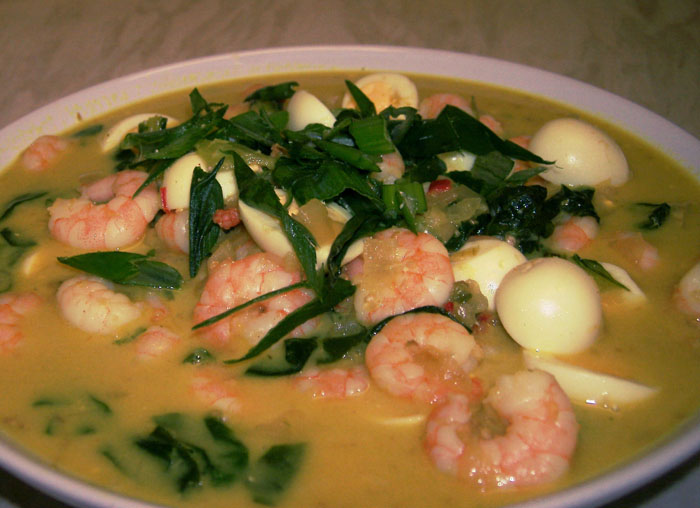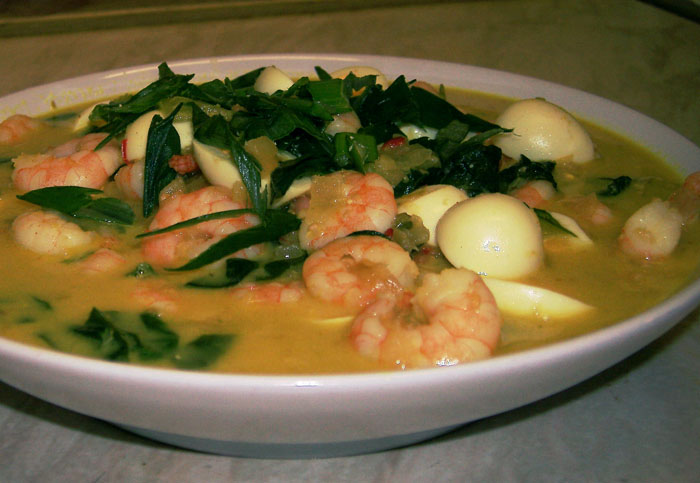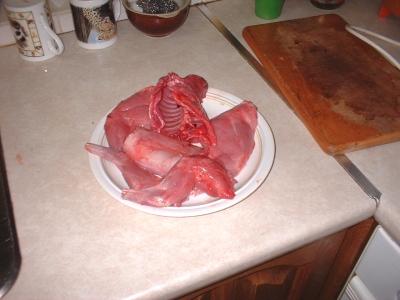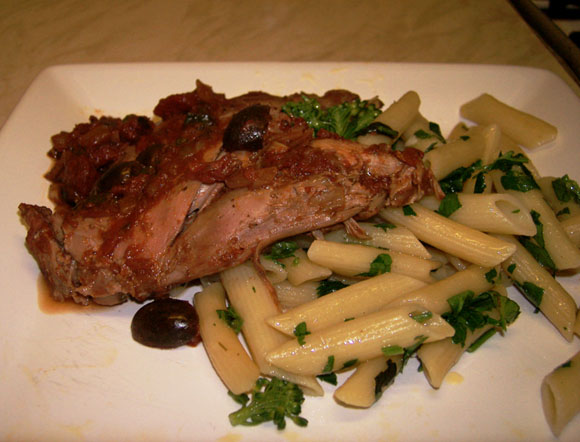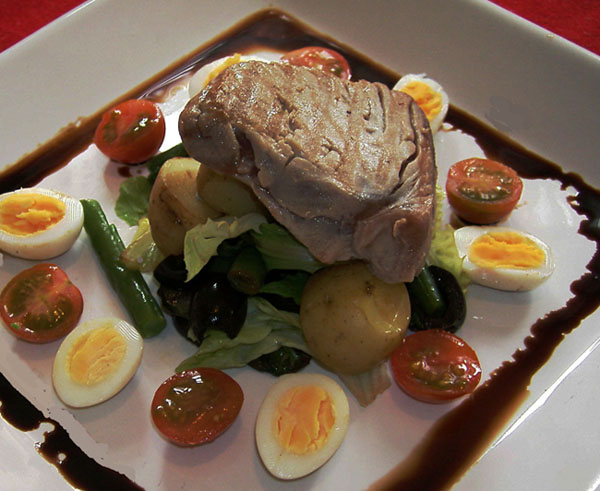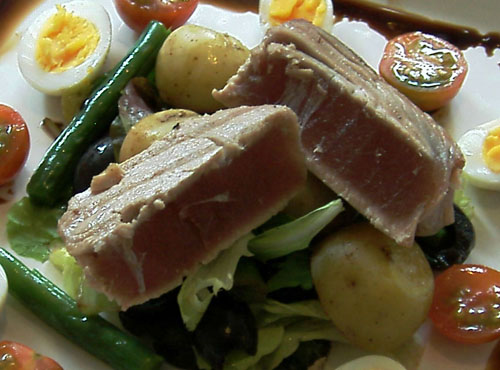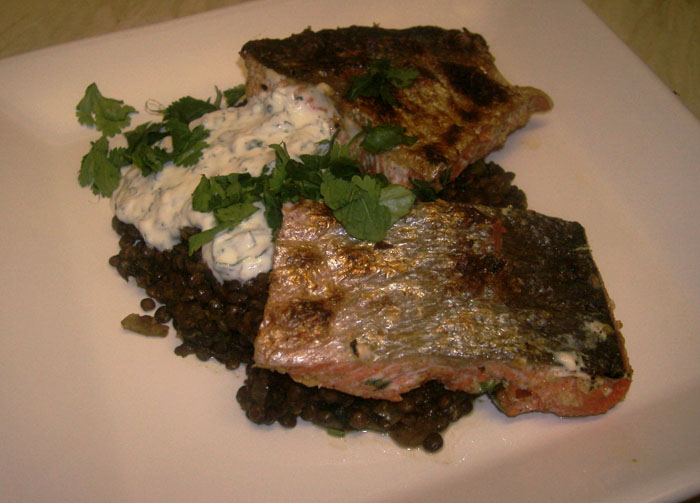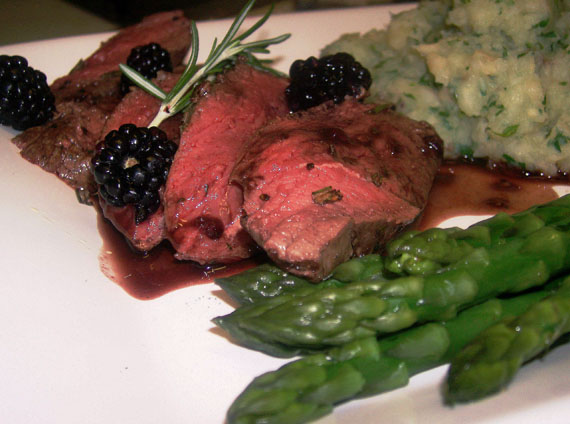
Calf liver is my treat for when Goon is away. It’s an automatic reaction now. If Goon is going away to work on his business or visit his parents, I head straight into Borough Market, find my way to the Ginger Pig and buy myself the nicest bit of veal liver they have. You see Goon isn’t a big liver fan. He can cope with chicken livers providing I soak them in enough cream and alcohol, but he hates lamb liver and is ambivalent about calf liver.
At £25 per kilo, ambivalent isn’t allowed!
So calf liver is reserved for the days when I have the flat to myself. My problem is I always buy the liver without knowing what to do with it. Last weekend I was after a change from the usual creamy marsala sauce but the internet was providing little inspiration. In fact, the recipe websites seem alost saturated with straightforward liver, bacon and onion recipes. That’s not quite what I wanted for my treat!
Eventually an idea came from an old BBC recipe. A liver, bacon and onion recipe by Gary Rhodes involves serving liver with melting onions with marmalade. A bit of musing led to the recipe below. Unfortunately, due to the great Islington juniper shortage that hit last weekend, I didn’t sprinkle my calf liver in finely ground juniper as intended. Instead, I dusted it with 1 juniper berry I had left, after giving it a good soak in gin.
Then I gave my own liver a good soak in gin. Happy times. 
Calf Liver with Juniper, Caramelised Apples, Maple Cure Bacon and Tangy Apple Onions
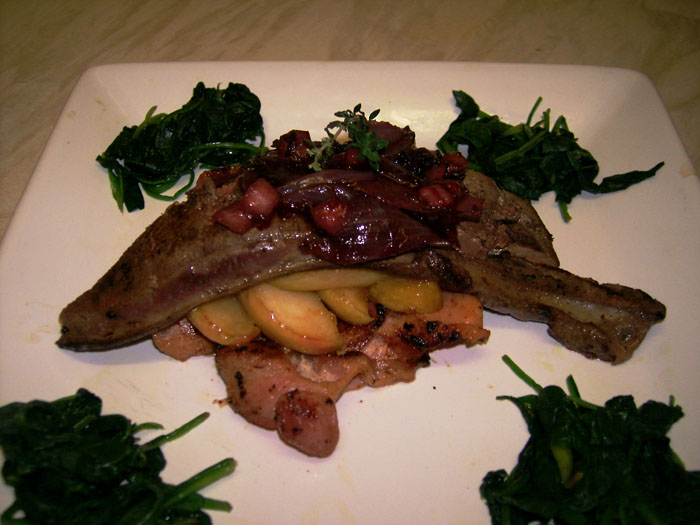
- 200g calf liver
- around 8 juniper berries, finely crushed
- 1 apple, peeled, cored and cut into 6 pieces
- around a level tablespoon of honey
- around 30g-40g butter
- 2 sprigs rosemary
- 2 rashers maple cure bacon
- half a small onion, sliced
- a tablespoon of apple sauce
- a tiny bit of balsamic vinegar and sugar to taste
- half a glass of fruity red wine
Sprinkle the liver with finely crushed juniper berries and press them in properly (or soak it in gin!). I suggest the calf liver is cooked to pink in the middle. For the liver you see in the picture, that involved dry frying for approimately 30 seconds on each side and resting for 5 minutes wrapped in foil.
Melt 3/4 of the butter over a low heat in a small saucepan and stir in the honey. Add the rosemary sprigs and allow to infue for a minute or two. Add the apple slices, sir to coat in the butter. Turn the heat up slighty so the apples caramelise. They should be golden brown on the outside, but firm. Discard the rosemary sprigs before serving.
The bacon was grilled until crisp. Easy
And for the onions, the only involved part of the meal, soften them in the rest of the butter until golden brown, add half a glass of red wine, allow to bubble down until almost completely evaporated then stir in a tablespoon of apple sauce. Add balsamic vinegar to taste- this will depend very much on how sweet/tart your apple sauce was. Calf liver has a delicate flavour compared to, for example, lamb liver, so you don’t want the onion to be overwhelmingly tart, just slightly tangy. I doubt you’ll need to add sugar but it is probably worth having some on hand just in case.
I served this with some simple buttered wilted spinach but spiced braised red cabbage would also be good.
Calf liver is my treat for when Goon is away. It’s an automatic reaction now. If Goon is going away to work on his business or visit his parents, I head straight into Borough Market, find my way to the Ginger Pig and buy myself the nicest bit of veal liver they have. You see Goon isn’t a big liver fan. He can cope with chicken livers providing I soak them in enough cream and alcohol, but he hates lamb liver and is ambivalent about calf liver.
At £25 per kilo, ambivalent isn’t allowed!
So calf liver is reserved for the days when I have the flat to myself. My problem is I always buy the liver without knowing what to do with it. Last weekend I was after a change from the usual creamy marsala sauce but the internet was providing little inspiration. In fact, the recipe websites seem alost saturated with straightforward liver, bacon and onion recipes. That’s not quite what I wanted for my treat!
Eventually an idea came from an old BBC recipe. A liver, bacon and onion recipe by Gary Rhodes involves serving liver with melting onions with marmalade. A bit of musing led to the recipe below. Unfortunately, due to the great Islington juniper shortage that hit last weekend, I didn’t sprinkle my calf liver in finely ground juniper as intended. Instead, I dusted it with 1 juniper berry I had left, after giving it a good soak in gin.
Then I gave my own liver a good soak in gin. Happy times. ![]()
Calf Liver with Juniper, Caramelised Apples, Maple Cure Bacon and Tangy Apple Onions

- 200g calf liver
- around 8 juniper berries, finely crushed
- 1 apple, peeled, cored and cut into 6 pieces
- around a level tablespoon of honey
- around 30g-40g butter
- 2 sprigs rosemary
- 2 rashers maple cure bacon
- half a small onion, sliced
- a tablespoon of apple sauce
- a tiny bit of balsamic vinegar and sugar to taste
- half a glass of fruity red wine
Sprinkle the liver with finely crushed juniper berries and press them in properly (or soak it in gin!). I suggest the calf liver is cooked to pink in the middle. For the liver you see in the picture, that involved dry frying for approimately 30 seconds on each side and resting for 5 minutes wrapped in foil.
Melt 3/4 of the butter over a low heat in a small saucepan and stir in the honey. Add the rosemary sprigs and allow to infue for a minute or two. Add the apple slices, sir to coat in the butter. Turn the heat up slighty so the apples caramelise. They should be golden brown on the outside, but firm. Discard the rosemary sprigs before serving.
The bacon was grilled until crisp. Easy
And for the onions, the only involved part of the meal, soften them in the rest of the butter until golden brown, add half a glass of red wine, allow to bubble down until almost completely evaporated then stir in a tablespoon of apple sauce. Add balsamic vinegar to taste- this will depend very much on how sweet/tart your apple sauce was. Calf liver has a delicate flavour compared to, for example, lamb liver, so you don’t want the onion to be overwhelmingly tart, just slightly tangy. I doubt you’ll need to add sugar but it is probably worth having some on hand just in case.
I served this with some simple buttered wilted spinach but spiced braised red cabbage would also be good.
